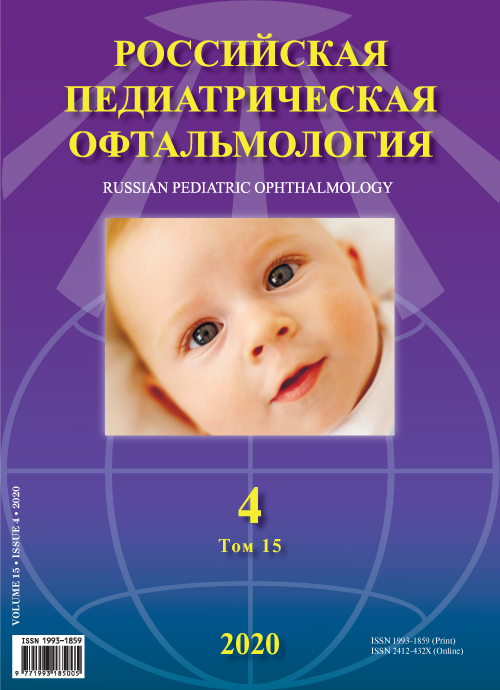Analysis of retinoblastoma incidence in children
- 作者: Saakyan S.V.1, Tadevosyan S.S.1, Tsygankov A.I.1
-
隶属关系:
- Helmholtz National Medical Research Center of Eye Diseases
- 期: 卷 15, 编号 4 (2020)
- 页面: 5-10
- 栏目: Clinical studies
- ##submission.datePublished##: 15.12.2020
- URL: https://ruspoj.com/1993-1859/article/view/48895
- DOI: https://doi.org/10.17816/rpo2020-15-4-5-10
- ID: 48895
如何引用文章
详细
Purpose. Compare the staging of retinoblastoma (RB) at the initial presentation according to the TNM classification in the periods 1994-1998 and 2004-2008.
Methods. 332 patients with RB were included in a retrospective study. The patients were examined and treated in the periods from 1994 to 1998 (n=162, group 1), from 2004 to 2008 (n=170, group 2). Monolateral RB in group 1 was diagnosed in 73.5% of cases (n=119), bilateral RB - in 26.5% (n=43). Monolateral RB in group 2 was diagnosed in 64.7% of cases (n = 110), bilateral RB - in 35.3% (n=60).
Results. There was no difference between the groups in the frequency of T1 and T2 stages. Monolateral stage T3 RB was detected in group 1 in 47.9% of cases, which is significantly less than in group 2 - 93.6% (p=0.0001). Monolateral stage T4 with RB was diagnosed in 47.9% of eyes in group 1, which is significantly more frequent than in group 2 - 3.6% (p=0.0001). Bilateral stage T3 RB in group 1 was detected in 61.6% of eyes, which is significantly less than in group 2 - 80% (p=0.004). Stage T4 in group 1 was diagnosed in 20.9% of eyes, which is significantly more frequent than in group 2 - 0.8% (p=0.0001). The most common stage was T3.
Conclusions. Analysis of the morbidity structure in children with primary retinoblastoma showed that, thanks to the introduction of new diagnostic technologies, in the second period, the amount of extrabulbar growth significantly decreased. At the same time, the frequency of children admitted in the early stages remains low, and intraocular retinoblastoma of stage T3 remains the most common in both binocular and monocular forms. Despite this, the introduction of new treatment technologies has made it possible to expand the indications for organ-preserving treatment.
全文:
作者简介
Svetlana Saakyan
Helmholtz National Medical Research Center of Eye Diseases
Email: svsaakyan@yandex.ru
ORCID iD: 0000-0001-8591-428X
M.D., Ph.D., Prof., head of ocular oncology and radiology department
俄罗斯联邦, 105062, Moscow, Sadovaya-Chernogryazskaya str.14/19Syuzanna Tadevosyan
Helmholtz National Medical Research Center of Eye Diseases
编辑信件的主要联系方式.
Email: syuzanna9.05@mail.ru
ORCID iD: 0000-0001-9098-5912
M.D., PhD-student at ocular oncology and radiology department
俄罗斯联邦, 105062, Moscow, Sadovaya-Chernogryazskaya str.14/19Alexander Tsygankov
Helmholtz National Medical Research Center of Eye Diseases
Email: alextsygankov1986@yandex.ru
ORCID iD: 0000-0001-9475-3545
M.D., PhD. researcher at ocular oncology and radiology department
俄罗斯联邦, 105062, Moscow, Sadovaya-Chernogryazskaya str.14/19参考
- Saakyan SV. Retinoblastoma (clinical features, diagnosis, treatment). Moscow: Meditsina; 2005. 200 p. (In Russ).
- Brovkina AF, Panteleeva OG. The results of retinoblastoma treatment. Vestnik oftal’mologii. 1995;111(3):12-14. (In Russ).
- Saakyan SV. Modern approaches to the treatment of retinoblastoma. Rossiiskii oftal’mologicheskii zhurnal. 2008;(1):33-38. (In Russ).
- Saakyan SV, Kharlampidi MP, Ivanova OA, et al. The role of intravitreal chemotherapy with melfalan in the combined treatment of retinoblastoma with endophitic character of growth. Effektivnaya farmakoterapiya. 2019;15(33):8-13. (In Russ). doi: 10.33978/2307-3586-2019-15-33-8-12
- Dimaras H, Kimani K, Dimba EA, et al. Retinoblastoma. Lancet. 2012;379(9824):1436-1446. doi: 10.1016/s0140-6736(11)61137-9
- Kivelä T. The epidemiological challenge of the most frequent eye cancer: retinoblastoma, an issue of birth and death. Br J Ophthalmol. 2009;93:1129-1131. doi: 10.1136/bjo.2008.150292
- Parrilla-Vallejo M, Perea-Pérez R, Relimpio-López I, et al. Retinoblastoma: the importance of early diagnosis. Arch Soc Esp Oftalmol. 2018;93(9):423-430. doi: 10.1016/j.oftal.2018.04.010
- Global Retinoblastoma Study Group. Global retinoblastoma presentation and analysis by national income level. JAMA Oncol. 2020;6(5):685-695. doi: 10.1001/jamaoncol.2019.6716
- Wilimas JA, Wilson MW, Haik BG, et al. Development of retinoblastoma programs in Central America. Pediatr Blood Cancer. 2009;53(1):42-46. doi: 10.1002/pbc.21984.
- Saakyan SV, Myakoshina EB, Denisova EV. The application of optical coherent tomography for differential diagnostics of small retinoblastomas and «pseudoretinoblastomas» in the children. Rossiiskaya pediatricheskaya oftal’mologiya. 2015;(4):22-25. (In Russ).
- Shields CL, Mashayekhi A, Au AK, et al. The International Classification of Retinoblastoma Predicts Chemoreduction Success. Ophthalmology. 2006;113:2276–2280. doi: 10.1016/j.ophtha.2006.06.018
补充文件








